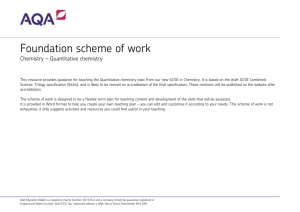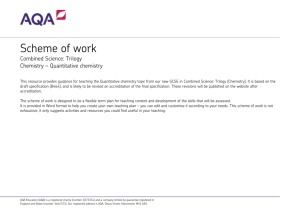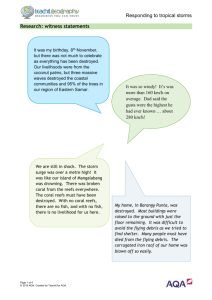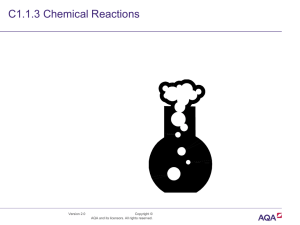Scheme of work
advertisement
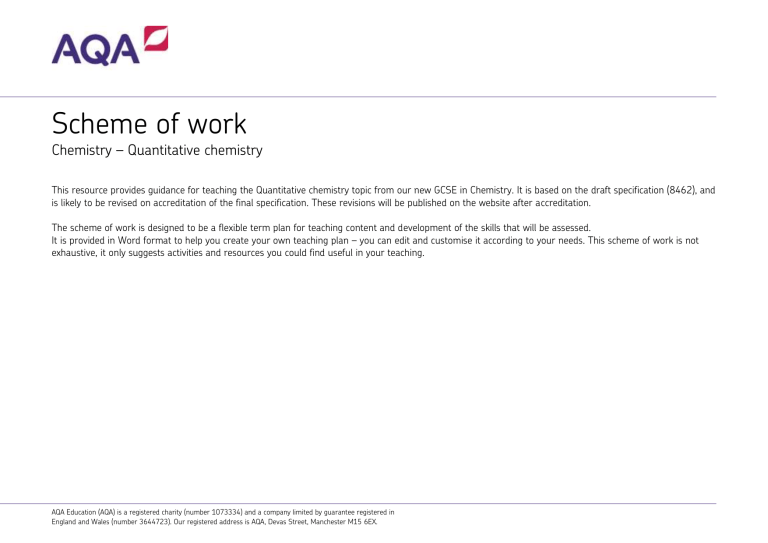
Scheme of work Chemistry – Quantitative chemistry This resource provides guidance for teaching the Quantitative chemistry topic from our new GCSE in Chemistry. It is based on the draft specification (8462), and is likely to be revised on accreditation of the final specification. These revisions will be published on the website after accreditation. The scheme of work is designed to be a flexible term plan for teaching content and development of the skills that will be assessed. It is provided in Word format to help you create your own teaching plan – you can edit and customise it according to your needs. This scheme of work is not exhaustive, it only suggests activities and resources you could find useful in your teaching. AQA Education (AQA) is a registered charity (number 1073334) and a company limited by guarantee registered in England and Wales (number 3644723). Our registered address is AQA, Devas Street, Manchester M15 6EX. 4.3 Quantitative chemistry 4.3.1 Conservation of mass and the quantitative interpretation of chemical equations Spec ref. Summary of the specification content Learning outcomes What most candidates should be able to do 4.3.1.1 The law of conservation of mass states that no atoms are lost or made during a chemical reaction so the mass of the products equals the mass of the reactants. This means that chemical reactions can be represented by symbol equations which are balanced in terms of the numbers of atoms of each element involved on both sides of the equation. Students should understand the use of the multipliers in equations in normal script before a formula and in subscript within a formula. 4.3.1.2 The relative formula mass (Mr) of a compound is the sum of the relative atomic masses of the atoms in the numbers shown in the Suggested timing (hours) 2 Opportunities to develop Scientific Communication skills Opportunities to develop and apply practical and enquiry skills Explain the meaning of the law of conservation. Model the law of conservation using molecular model kits. Write simple word equations. Write simple symbol equations. WS 1.2 Lego or Duplo bricks can be used to good effect. Teacher demonstration. The precipitation reaction: Balance symbol equations. Extended writing: describe the equations given in terms of number of moles, reactants and products. Students are expected to use relative atomic masses in the calculations specified in the subject content. 1 Grade 9: balance complex equations and add state symbols. Review the definition of relative atomic mass. lead nitrate + potassium iodide can be performed on a balance. No change in total mass but obvious yellow precipitate observed. Model mixtures. WS 2.2, 2.3, 4.1 Recall how to find the relative atomic mass from AQA Education (AQA) is a registered charity (number 1073334) and a company limited by guarantee registered in England and Wales (number 3644723). Our registered address is AQA, Devas Street, Manchester M15 6EX. Carry out chromatography Self/peer assessment opportunities and resources Reference to past questions that indicate success Video clips: BBC Bitesize Conservation of mass in chemical reactions YouTube: The law of conservation of mass Law of Conservation of Mass Experiment Exampro questions ref: Q11WY2F07 Q10WY2H03 Q08W.2F.08 2 of 13 Spec ref. Summary of the specification content Learning outcomes What most candidates should be able to do formula. In a balanced chemical equation, the sum of the relative formula masses of the reactants in the quantities shown equals the sum of the relative formula masses of the products in the quantities shown. Students should be able to calculate the relative formula mass (Mr) of a compound from its formula, given the relative atomic masses. Suggested timing (hours) Opportunities to develop Scientific Communication skills Opportunities to develop and apply practical and enquiry skills the Periodic Table. techniques using sweets or felt tip pens. Define the relative molecular mass. Extended writing: write instructions to another student how to calculate the relative formula mass. MS 3a Demo distillation of citrus peel. Carry out crystallisation using salol. Self/peer assessment opportunities and resources Reference to past questions that indicate success Q08S.2F.07 QB03.F.20 QSB99.2.10 QA05DF2.6C QM95R6.09 QM97H6.13 QM98F2.11 Carry out filtration and evaporation of sea water. 4.3.1.3 Some reactions may appear to involve a change in mass but this can usually be explained because a reactant or product is a gas and its mass has not been taken into account. For example: when a metal reacts with oxygen the mass of the oxide produced is greater than the mass of the metal or in thermal decompositions of metal carbonates carbon Students should be able to explain any observed changes in mass in nonenclosed systems during a chemical reaction given the balanced symbol equation for the reaction and explain these changes in terms of the particle model. 1 Extended writing: use measurements of mass before and after an experiment to explain what has happened to the mass during the experiment and why it has happened. WS 1.2 AQA Education (AQA) is a registered charity (number 1073334) and a company limited by guarantee registered in England and Wales (number 3644723). Our registered address is AQA, Devas Street, Manchester M15 6EX. Show that mineral waters are not ‘pure’ in the scientific sense. Use magnesium ribbon to produce magnesium oxide. Measure the mass of the ribbon at the start of the experiment, burn the ribbon in a strong Bunsen flame (SAFETY required) and measure the mass of the ribbon at the end of the experiment. Use HCl acid in a conical flask with CaCO3. Measure 3 of 13 Spec ref. Summary of the specification content Learning outcomes What most candidates should be able to do Suggested timing (hours) Opportunities to develop Scientific Communication skills dioxide is produced and escapes into the atmosphere leaving the metal oxide as the only solid product. Opportunities to develop and apply practical and enquiry skills Self/peer assessment opportunities and resources Reference to past questions that indicate success the mass of the reaction on a top pan balance as the reaction proceeds over two minutes. Demonstrate combustion of paper in a large beaker to show mass may decrease because products are released to the air as gases. Try balancing iron wool on a pair of scales (a makeshift one can be set up using a carefully balanced metre rule). Heat the iron wool strongly to observe the increase in mass of the oxide. AQA Education (AQA) is a registered charity (number 1073334) and a company limited by guarantee registered in England and Wales (number 3644723). Our registered address is AQA, Devas Street, Manchester M15 6EX. Video clip YouTube: BBC Chemical reactions Burning iron wool experiment at 7 minutes in. 4 of 13 4.3.2 Use of amount of substance in relation to masses of pure substances Spec ref. Summary of the specification content Learning outcomes What most candidates should be able to do 4.3.2.1 (HT only) Chemical amounts are measured in moles. The symbol for the unit mole is mol. The mass of one mole of a substance in grams is numerically equal to its relative formula mass. One mole of a substance contains the same number of the stated particles, atoms, molecules or ions as one mole of any other substance. The number of atoms, molecules or ions in a mole of a given substance is the Avogadro constant. The value of the Avogadro constant is 6.02 x 1023 per mole. Students should understand that the measurement of amounts in moles can apply to atoms, molecules, ions, electrons, formulae and equations, for example that in one mole of carbon (C) the number of atoms is the same as the number of molecules in one mole of carbon dioxide (CO2). Students should be able to use the relative formula mass of a substance to calculate the number of moles in a given mass of that substance and vice versa. Suggested timing (hours) 1 Opportunities to develop Scientific Communication skills Opportunities to develop and apply practical and enquiry skills Define one mole in terms of Mr and Ar Measure out and compare 1 mole of elements like iron, sulfur, magnesium, copper, aluminium and so on. Calculate the number of moles in a substance using the relative formula mass. Extended writing: write instructions to another student how to calculate the number of moles using the relative formula mass Measure out and compare one mole of common compounds, water, sodium chloride, calcium carbonate and so on. Self/peer assessment opportunities and resources Reference to past questions that indicate success Video clips YouTube: What is a mole? Avogadro’s number – The mole WS 4.1, 4.2, 4.3, 4.5, 4.6 MS 1a, 1b, 2a, 3b, 3c AQA Education (AQA) is a registered charity (number 1073334) and a company limited by guarantee registered in England and Wales (number 3644723). Our registered address is AQA, Devas Street, Manchester M15 6EX. 5 of 13 Spec ref. Summary of the specification content Learning outcomes What most candidates should be able to do 4.3.2.2 (HT only) The masses of reactants and products can be calculated from balanced symbol equations. Chemical equations can be interpreted in terms of moles. For example: Students should be able to: calculate the masses of substances shown in a balanced symbol equation calculate the masses of reactants and products from the balanced symbol equation and the mass of a given reactant or product. 𝑀𝑔 + 2𝐻𝐶𝑙 𝑀𝑔𝐶𝑙2 + 𝐻2 shows that one mole of magnesium reacts with two moles of hydrochloric acid to produce one mole of magnesium chloride and one mole of hydrogen gas. 4.3.2.3 (HT only) The balancing numbers in a symbol equation can be calculated from the masses of reactants and products by converting the masses in grams to amounts in moles and converting the numbers of moles to simple whole number ratios. Suggested timing (hours) 1 Opportunities to develop Scientific Communication skills Balance chemical equations and use these to calculate the masses of substances present. Extended writing: write instructions to another student use balanced chemical equations to calculate the masses of substances present. MS 1a, 1c, 3c, 3d Students should be able to balance an equation given the masses of reactants and products. MS 3c, 3d 1 Opportunities to develop and apply practical and enquiry skills Self/peer assessment opportunities and resources Reference to past questions that indicate success Video clip YouTube: Calculating Masses in Reactions Exampro references: Q14S.IP1.05 Q13W.Y2F.08 Q11SY2H06 QSP.2H.09 Q09W.2F.07 Q09W.2H.08 Q09W.3H.6B QO9S.2F.08 Use the masses of substances present in a reaction to write a balanced equation. AQA Education (AQA) is a registered charity (number 1073334) and a company limited by guarantee registered in England and Wales (number 3644723). Our registered address is AQA, Devas Street, Manchester M15 6EX. 6 of 13 Spec ref. Summary of the specification content Learning outcomes What most candidates should be able to do 4.3.2.4 (HT only) In a chemical reaction involving two reactants, it is common to use an excess of one of the reactants to ensure that all of the other reactant is used. The reactant that is completely used up is called the limiting reactant because it limits the amount of products. Many chemical reactions take place in solutions. The concentration of a solution can be measured in mass per given volume of solution, eg grams per dm3 (g/dm3). Students should be able to explain the effect of a limiting quantity of a reactant on the amount of products it is possible to obtain in terms of amounts in moles or masses in grams. 4.3.2.5 (HT only) WS 4.1 Students should be able to: explain how the mass of a solute and the volume of a solution is related to the concentration of the solution calculate the mass of solute in a given volume of solution of known concentration in terms of mass per given volume of solution. MS 1c, 3c Suggested timing (hours) Opportunities to develop Scientific Communication skills Opportunities to develop and apply practical and enquiry skills 0.5 Define the term limiting reactant. Link the limiting reactant to the number of moles. Link the limiting reactant to the masses in grams. Use a small strip of magnesium ribbon in 20 ml HCl acid. Identify which reactant is the limiting reactant and state the reason for this choice. 0.5 Explain the meaning of concentration and the unit grams per dm3 To demonstrate the idea of concentration students could make different concentrations of tea, coffee or a dark squash like blackcurrant. Be able to convert cm 3 into dm3 . Self/peer assessment opportunities and resources Reference to past questions that indicate success Video clip YouTube: Concentration formula and calculations Use the equation: 𝐶 = 𝑚/𝑣 to calculate the concentration of a solution. Rearrange the equation: 𝐶 = 𝑚/𝑣 to make mass the subject. Extended writing: write instructions to another AQA Education (AQA) is a registered charity (number 1073334) and a company limited by guarantee registered in England and Wales (number 3644723). Our registered address is AQA, Devas Street, Manchester M15 6EX. 7 of 13 Spec ref. Summary of the specification content Learning outcomes What most candidates should be able to do Suggested timing (hours) Opportunities to develop Scientific Communication skills student on how to calculate the concentration, or how to rearrange the equation to calculate mass. Discuss the differences of the word ‘concentration’ and ‘strength’ in science and everyday language. AQA Education (AQA) is a registered charity (number 1073334) and a company limited by guarantee registered in England and Wales (number 3644723). Our registered address is AQA, Devas Street, Manchester M15 6EX. Opportunities to develop and apply practical and enquiry skills Self/peer assessment opportunities and resources Reference to past questions that indicate success Students often confuse the concept of ‘concentration’ with ‘strength’. 8 of 13 4.3.3 Yield and atom economy of chemical reactions Spec ref. Summary of the specification content Learning outcomes What most candidates should be able to do 4.3.3.1 Even though no atoms are gained or lost in a chemical reaction, it is nt always possible to obtain the calculated amount of a product because: the reaction may not go to completion because it is reversible some of the product may be lost when it is separated from the reaction mixture some of the reactants may react in ways different to the expected reaction. The amount of a product obtained is known as the yield. When compared with the maximum theoretical amount as a percentage, it is called the percentage yield. % 𝑌𝑖𝑒𝑙𝑑 = Students should be able to: calculate the theoretical amount of a product from a given amount of reactant and the balanced equation for the reaction calculate the percentage yield of a product from the actual yield of a reaction. WS 4.2, 4.6 MS 1a, 1c, 2a, 3c Suggested timing (hours) 1 Opportunities to develop Scientific Communication skills Opportunities to develop and apply practical and enquiry skills Describe how atoms are lost or gained in a chemical reaction. Use Lego as a model for chemical reactions demonstrating the loss of product and use the model as a simple introduction to yield calculations. Explain why atoms can be lost or gained in a chemical reaction. Calculate the theoretical yield for simple examples. Extended writing: write instructions to another student how to calculate the theoretical yield giving explained examples. Self/peer assessment opportunities and resources Reference to past questions that indicate success Video clips YouTube: Theoretical yield and losses Percentage yield The same can be applied to atom economy. Yield calculations Exampro ref: QM98H2.08 QSP.2H.09 Q09W.2H.08 𝑀𝑎𝑠𝑠 𝑜𝑓 𝑝𝑟𝑜𝑑𝑢𝑐𝑡 𝑎𝑐𝑡𝑢𝑎𝑙𝑙𝑦 𝑚𝑎𝑑𝑒 𝑀𝑎𝑥𝑖𝑚𝑢𝑚 𝑡ℎ𝑒𝑜𝑟𝑒𝑡𝑖𝑐𝑎𝑙 𝑚𝑎𝑠𝑠 𝑜𝑓 𝑝𝑟𝑜𝑑𝑢𝑐𝑡 𝑥 100 AQA Education (AQA) is a registered charity (number 1073334) and a company limited by guarantee registered in England and Wales (number 3644723). Our registered address is AQA, Devas Street, Manchester M15 6EX. 9 of 13 Spec ref. Summary of the specification content Learning outcomes What most candidates should be able to do 4.3.3.2 The atom economy (atom utilisation) is a measure of the amount of starting materials that end up as useful products. It is important for sustainable development and for economic reasons to use reactions with high atom economy. Students should be able to: calculate the atom economy of a reaction to form a desired product from the balanced equation explain why a particular reaction pathway is chosen to produce a specified product given appropriate data such as atom economy (if not calculated), yield, rate, equilibrium position and usefulness of byproducts. The percentage atom economy of a reaction is calculated using the balanced equation for the reaction as follows: 𝑅𝑒𝑙𝑎𝑡𝑖𝑣𝑒 𝑓𝑜𝑟𝑚𝑢𝑙𝑎 𝑚𝑎𝑠𝑠 𝑜𝑓 𝑑𝑒𝑠𝑖𝑟𝑒𝑑 𝑝𝑟𝑜𝑑𝑢𝑐𝑡 𝑓𝑟𝑜𝑚 𝑒𝑞𝑢𝑎𝑡𝑖𝑜𝑛 𝑆𝑢𝑚 𝑜𝑓 𝑟𝑒𝑙𝑎𝑡𝑖𝑣𝑒 𝑓𝑜𝑟𝑚𝑢𝑙𝑎 𝑥 𝑚𝑎𝑠𝑠𝑒𝑠 𝑜𝑓 𝑎𝑙𝑙 𝑟𝑒𝑎𝑐𝑡𝑎𝑛𝑡𝑠 𝑓𝑟𝑜𝑚 𝑒𝑞𝑢𝑎𝑡𝑖𝑜𝑛 100% Suggested timing (hours) 1 Opportunities to develop Scientific Communication skills Opportunities to develop and apply practical and enquiry skills Calculate the atom economy for simple examples. Identify a chemical reaction that has a high atom economy and research the positives to industry of producing a high yield of useful product. Extended writing: write instructions to another student how to calculate the atom economy giving explained examples. Self/peer assessment opportunities and resources Reference to past questions that indicate success Video clip YouTube: What is the Atom Economy? Identify a chemical reaction that has a low atom economy and research the negatives to industry of producing a low yield of useful product and ways the reactions has been improved to increase the yield of useful product. WS 4.1, 4.2 MS 1a, 1c, 3c AQA Education (AQA) is a registered charity (number 1073334) and a company limited by guarantee registered in England and Wales (number 3644723). Our registered address is AQA, Devas Street, Manchester M15 6EX. 10 of 13 4.3.4 Using concentrations of solutions in mol/dm3 Spec ref. Summary of the specification content Learning outcomes What most candidates should be able to do 4.3.4 (HT only) The concentration of a solution can be measured in mol/dm3. Students should be able to: describe how to carry out titrations using strong acids and strong alkalis only (sulfuric, hydrochloric and nitric acids only) calculate the chemical quantities in titrations involving concentrations in mol/dm3 and in g/dm3 explain how the concentration of a solution in mol/dm3 is related to the mass of the solute and the volume of the solution. The amount in moles of solute or the mass in grams of solute in a given volume of solution can be calculated from its concentration in mol/dm3. If the volumes of two solutions that react completely are known and the concentration of one solution is known, the concentration of the other solution can be calculated. The volumes of acid and alkali solutions that react with each other can be measured by titration using a suitable indicator. WS 4.2, 4.3, 4.6 MS 1a, 1c, 3c, 3d Suggested timing (hours) 1 Opportunities to develop Scientific Communication skills Opportunities to develop and apply practical and enquiry skills Explain the meaning of concentration and the unit mol per dm3 . Be able to convert cm 3 into dm3 . Use the equation 𝐶 = 𝑛/𝑣 to calculate the concentration of a solution. Rearrange the equation 𝐶 = 𝑚/𝑣 to make number of moles the subject. Extended writing: write instructions to another student on how to calculate the concentration, or how to rearrange the equation to calculate number of moles Extended writing: write instructions to another student on how to carry out a titration. Include reasons for using a burette instead Titrate HCl with NaOH using an indicator of methyl orange. Use the titre results and know volumes of NaOH and concentration, to calculate the concentration of the HCl. AQA Education (AQA) is a registered charity (number 1073334) and a company limited by guarantee registered in England and Wales (number 3644723). Our registered address is AQA, Devas Street, Manchester M15 6EX. Self/peer assessment opportunities and resources Reference to past questions that indicate success Video clip YouTube: Concentration formula and calculations Concentration Calculations Exampro ref: Q14S.3H.04 Q13W.Y3F.06 Q13S.IP2.03 Q13S.3F.09 Q10WY3F02 QSP.IP2.02 QSP.IP2.04 Q08W.3F.03 QO8W.3H.05 QB04.H.17 QSB02.507 11 of 13 Spec ref. Summary of the specification content Learning outcomes What most candidates should be able to do Suggested timing (hours) Opportunities to develop Scientific Communication skills Opportunities to develop and apply practical and enquiry skills Self/peer assessment opportunities and resources Reference to past questions that indicate success of other measuring equipment. Grade 9: explain why indicators eg methyl orange and phenolphthalein are used instead of Universal indicator. AQA Education (AQA) is a registered charity (number 1073334) and a company limited by guarantee registered in England and Wales (number 3644723). Our registered address is AQA, Devas Street, Manchester M15 6EX. 12 of 13 4.3.5 Use amount of substance in relation to volume of gases Spec ref. Summary of the specification content Learning outcomes What most candidates should be able to do 4.3.5 (HT only) Equal amounts in moles of gases occupy the same volume under the same conditions of temperature and pressure. Students should be able to: calculate the volume of a gas at room temperature and pressure from its mass and relative formula mass calculate volumes of gaseous reactants and products from a balanced equation and a given volume of a gaseous reactant or product. The volume of one mole of any gas at room temperature and pressure (20 °C and 1 atmosphere pressure) is 24 dm3. The volumes of gaseous reactants and products can be calculated from the balanced equation for the reaction. WS 1.2, 4.1, 4.2, 4.3, 4.6 MS 1a, 1c, 3c, 3d Suggested timing (hours) 0.5 Opportunities to develop Scientific Communication skills Opportunities to develop and apply practical and enquiry skills Self/peer assessment opportunities and resources Reference to past questions that indicate success Recall the equation: 𝑛𝑢𝑚𝑏𝑒𝑟 𝑜𝑓 𝑚𝑜𝑙𝑒𝑠 = 𝑚𝑎𝑠𝑠 𝑟𝑒𝑙𝑎𝑡𝑖𝑣𝑒 𝑓𝑜𝑟𝑚𝑢𝑙𝑎 𝑚𝑎𝑠𝑠 Use the equation: volume of gas at rtp = number of moles x molar gas volume (24 dm3) for simple examples. Extended writing: write instructions to another student on how to calculate the volume of a gas. Use balanced equations and known volume of reactant/product to calculate the volumes of gaseous reactants/ products. AQA Education (AQA) is a registered charity (number 1073334) and a company limited by guarantee registered in England and Wales (number 3644723). Our registered address is AQA, Devas Street, Manchester M15 6EX. 13 of 13


